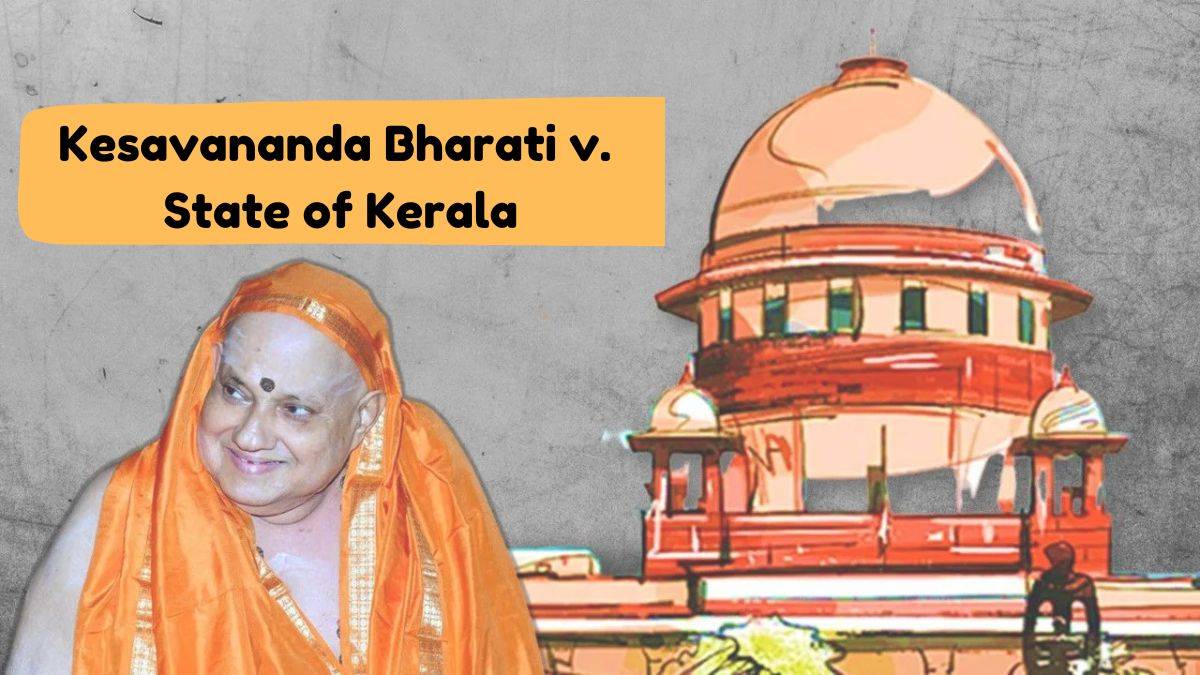Kesavananda Bharati v. State of Kerala Case: Facts, Judgement & Impact
The Kesavananda Bharati judgement of 1973 underlined and introduced the basic structure doctrine. It highlighted that Parliament can alter any part of the Constitution but not its basic structure. Read further to understand the facts of the case and the impact of the judgement.
The Kesavananda Bharati Judgement, also known as Basic Structure Doctrine Case is known to be one of the most significant constitutional law cases in India. Every Law student or those aspiring to study Law must know this landmark judgement and understand its significance. This case highlights that the Parliament has power to amend the Indian Constitution but the power to alter its fundamental framework or basic features is limited.
The Kesavananda Bharti case was decided by a 13-judge bench of the Supreme Court, which is said to be the largest bench formed to decide any case in history. Kesavananda Bharati was the head of a religious mutt in Kerala. The case arose when Kerala government passed two land reforms in the state. These state land reforms restricted the property rights of the mutt and thus, were challenged before the State court. However, as the case hearing around the property rights evolved, it highlighted other broader question such as, Does Parliament have unlimited power to amend the Constitution under Article 368, including fundamental rights?
Eventually, the case reached to Supreme Court, which ruled it in favor of the State Government. But due to the Kesavananda Bharti case, the Supreme Court introduced the Basic Structure Doctrine. This doctrine explains that Parliament can amend any part of the Constitution, however, the basic structure which is the foundation of the Constitution of India cannot be altered. The basic structure includes Democracy, Rule of Law, Secularism, Judicial Review, and Fundamental Rights. The Doctrine of Basic Structure remains the cornerstone of constitutional interpretation in India.
This landmark judgement is asked in major Law entrance exams such as Common Law Admission Test (CLAT 2026), Telangana LAWCET, All India Bar Examination (AIBE 2025), Andhra Pradesh LAWCET, MH CET Law 2025, etc. Candidates aspiring to participate in any of the national or state-level entrance exams must know the important facts and significance of this case.
Facts of the Kesavananda Bharati v. State of Kerala (1973) Case
Below are the important facts of the Kesavananda Bharti case:
- The petitioner of the case was Kesavananda Bharati was the head (Mathadhipathi) of the Edneer Mutt (a Hindu monastery) in Kerala. The respondent of the case was State of Kerala and the Union of India.
- The filing date for the Kesavananda Bharati case was March 21, 1970. Kesavananda Bharati filed the writ petition under Article 32 of the Indian Constitution to challenge the validity of the Kerala Land Reforms Act, 1963 and its subsequent amendments.
- This case arose when the Kerala Government passed two land reform acts, namely, the Kerala Land Reforms Act, 1963, and Kerala Land Reforms (Amendment) Act, 1969. These land reforms restricted the management of land and property that belonged to the religious institutions, like the Edneer Mutt. Under these acts, the land was aimed to be redistributed from large land owners to the poor and landless people, and more equitably.
- As the act targeted the personal rights over the land held by Kesavananda Bharati or the people interested, he challenged these laws. The major argument was that these reforms violated his fundamental rights to property, freedom of religion, and management of religious affairs under Articles 25, 26, and 31 of the Constitution.
- Along with that, during the pendency of the Kesavananda Bharti case, the 24th, 25th, and 29th Constitutional Amendments were passed by Parliament, giving the legislature more power to amend the Constitution, including fundamental rights, as explained below:
- 24th Amendment (1971) gave Parliament explicit power to amend any part of the Constitution and curtailed the power of the judiciary and limited the scope of judicial review.
- 25th Amendment (1971) curtailed the right to property and limited judicial review over laws implementing Directive Principles.
- 29th Amendment (1972) placed certain Kerala land reform laws in the Ninth Schedule, making them immune from judicial review.
- Now the question arose, whether the Parliament has unlimited powers to amend the Constitutional norms under Article 368, including Fundamental Rights, or there can be certain limitations to such power.
The Kesavanada Bharti case (Basic Structure Doctrine Judgement) became a landmark case because it addressed the balance between supremacy of Parliament and Constitution. This case led to upheld the Doctrine of Basic Structure and limited the Parliamentary power to amend the Constitution.
Supreme Court Judgment on Kesavananda Bharati v. State of Kerala (1973)
The Supreme Court's landmark judgment in the Kesavananda Bharati v. State of Kerala case was delivered on April 24, 1973 by a 7:6 majority. The case was heard by the largest 13 judges bench in Indian judicial history of the Supreme Court.
The case acknowledged the supremacy of the Constitution and the independence of the judiciary in protecting the basic structure of the Constitution. The Kesavananda Bharati judgment also laid down several principles, including the principles rule of law, separation of powers, and the independence of the judiciary which are the root of Constitutional Law in India. The following are the Supreme Court judgments delivered during the Kesavananda Bharti case:
- Validity of Constitutional Amendments: The Court supported and upheld the 24th Amendment of the Constitution and 25th Amendments of the Constitution. With this, the court confirmed the Parliament’s power to amend the Constitution, including Fundamental Rights.
- Limitation on Parliament’s Power of Amendment: The Supreme Court ruled that Parliament’s power under Article 368 is not absolute or unlimited. Their power is subject to certain restrictions. The Parliament cannot alter, destroy, or abrogate the “basic structure” of the Constitution, even through constitutional amendments.
- Basic Structure consists of:
- Fundamental Rights
- Secularism
- Supremacy of the Constitution
- Rule of Law
- Separation of Powers
- Judicial Review
- Federalism
- Democracy and Secularism
- Right to Property: The court observed that the right to property (then a Fundamental Right under Article 31) could be restricted for implementing land reforms, but laws violating the basic structure of the Constitution would be invalid.
- Judicial Review: The Supreme Court reassured it right to review any amendment made by the parliaments.
- Impact of the Judgment: This judgment created a balance between the supremacy of Parliament and Constitution. This judgement became a permanent safeguard against authoritarian amendments.
- Golaknath Case Overruled: This case overruled the decision delivered in the Golaknath’s case which suggested that the Parliament had no power to amend the fundamental rights.
- Legacy of the Kesavananda Bharti Judgement: This case is now considered as the “Constitution’s savior” as the decision taken in the case ensures that core principles like democracy, fundamental rights, and judicial review cannot be dismantled by any government.
Landmark Judgements play a vital role in all the national-level or state-level Law entrance exams. Students aspiring to study and practice Law must know and understand the impact and importance of these landmark judgments of India. While preparing for the national-level CLAT entrance exams, students must refer to the best CLAT Books 2026 to prepare effectively.
Also Read:





